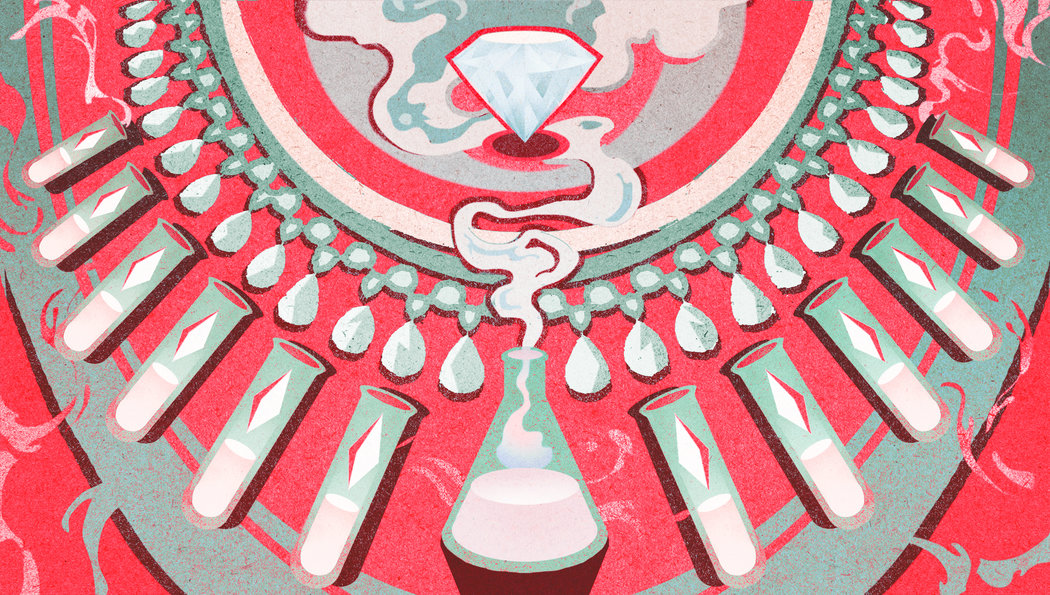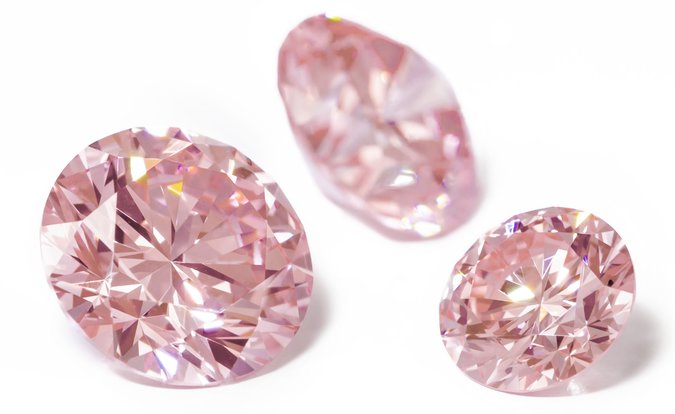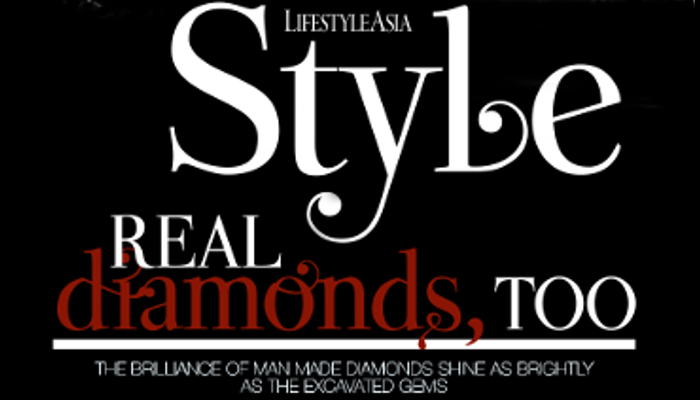Is That Rock for Real?
Purveyors of Grown Diamonds Seek Acceptance

According to guidelines from the Federal Trade Commission, an independent United States government agency, the terms “synthetic,” “lab-grown,” “man-made” and “(company)-created” are legitimate and interchangeable modifiers for diamonds created in a lab. Marketers, however, prefer to avoid the word “synthetic” because they fear that it has a negative connotation among consumers.
Beyond their origin in a lab as opposed to deep below the earth’s crust, the pinks on Ms. Bissell’s tray — which began as lab-grown colorless diamonds before undergoing a secondary coloration treatment — depart from their mined counterparts in one significant way: cost.
The artificial gems retail from $9,189 — for the smallest and faintest of them, a 1.2-carat fancy pink — to $21,898 for the most saturated, a 1.3-carat gem Ms. Bissell described as “fancy deep pink.”
Natural pink diamonds with saturated hues typically cost more than $100,000 per carat, sometimes much more. At a Christie’s New York jewelry sale on June 10, for example, a 5.5-carat oval-shaped fancy vivid pink diamond earned $9.6 million, or $1.7 million a carat.
Not all lab-grown diamonds offer such dramatic bargains. Most artificial colorless diamonds trade at 20 percent to 30 percent discounts compared with mined diamonds of a similar size, color and quality. Still, even at those reduced premiums, the synthetic diamond business has seen a swell of interest from designers, manufacturers and jewelers over the past year.
“The most critical part of the growth business is being honest and telling everybody, not once but a hundred times: ‘These are grown diamonds; they’re just like diamonds, except they’re grown above the ground instead of below the ground,”’ Ms. Bissell said. “The only negativity we encounter is within our own industry because they’re so fearful of things that aren’t even really possible.”
Fearful is an understatement. Scientists have been able to synthesize diamonds for the better part of 60 years, but the category has barely developed because the jewelry trade tends to ostracize purveyors of lab-grown diamonds.
“One reason jewelers don’t want to go into the synthetic diamond business is because they feel they’re cannibalizing mined diamonds,” Mr. Bates said. “It’s a hard balance.”
The conversation about lab-grown diamonds reached a fever pitch in June when members of the industry gathered for an annual jewelry trade fair at the Mandalay Bay Convention Center in Las Vegas.
On the show floor, Reena Ahluwalia, a Canadian designer, introduced Nurture by Reena, a sleek designer line featuring colorless, pink and yellow lab-grown diamonds. At a nearby booth, Kama Schachter, an Indian diamond and jewelry manufacturer, promoted a new lower-priced line of bridal rings called Kama’s Rox, using emerald-cut lab-grown diamonds as center stones.
Even as their presence signaled the product’s growing acceptance within the industry, worried members of the trade gathered in meeting rooms downstairs to discuss the threat that synthetics posed to the traditional diamond marketplace. Earlier that week, a lab in Israel announced that it had detected undisclosed artificial stones mixed with a parcel of natural mined diamonds. The news incited a panic.
“What will happen when the quality of man-made diamonds gets to be so good that labs will have trouble telling the difference?” asked Ben Janowski, founder of Janos Consultants in New York.
It is a valid question, and one the trade has been asking since 1954, when scientists at General Electric produced a synthetic diamond in a high-pressure, high-temperature growth chamber, simulating what happens inside the earth. Known as H.P.H.T., the method was denounced by the jewelry trade as the beginning of the end for natural diamonds.
“They were scared to death,” said Tom Chatham, chief executive of Chatham Created Gems & Diamonds in San Marcos, Calif., and a longtime advocate of lab-grown diamonds. “It took a while for everybody to realize it was a laboratory curiosity at that point — and not going to affect the jewelry industry.”
There are many reasons why it took so long for H.P.H.T.-grown diamonds to become more commonplace in the industry. For one thing, “nobody shares any information,” Mr. Chatham said. For another, the method is expensive and subject to the same vagaries that plague natural diamonds.
James Shigley, a research fellow at the Gemological Institute of America in Carlsbad, Calif., said, “The challenge for the grower is to create the conditions and maintain them at a steady level.”
“If you have some fluctuation in the temperature or pressure,” he added, “that’s reflected as some kind of defect in the diamond.”
In the 1990s, lab-grown diamond pioneers — notably a Boston company called Apollo Diamonds, now known as Scio Diamond Technology and based in Greenville, S.C. — turned their attention to chemical vapor deposition, or C.V.D., a method that allowed them to grow diamonds in less costly, and easier to manage, vacuum chambers.

Renaissance Diamonds
“You put a gas, like methane, into the end of the growth chamber and you have a source of energy like a microwave beam,” Mr. Shigley said. “And that makes the carbon atoms kind of rain down on a substrate.”
At first, the C.V.D. process yielded diamond wafers too thin to produce gem-quality diamonds. The method has since been refined, however, and now dozens of companies — many in China, India and the former Soviet republics — have jumped into the arena using variations on C.V.D. Most growers are drawn to the potential of synthetic diamonds for industrial applications in the semiconductor, nanotechnology and tooling equipment sectors; but some are eyeing the luxury market, if grudgingly.
The industrial diamond sector has become crowded with competing firms, “which makes people look over their shoulder to figure out what else they can produce to make their factories profitable,” Mr. Chatham said.
Among the leaders are powerful producers such as Element Six, the London-based synthetic division of the diamond miner De Beers, and Sumitomo Electric, a Japanese company that has been synthesizing diamonds since 1982.
“It’s a five-billion-carat-a-year business industrially today, so there are a lot of players up on making diamonds — except they don’t have any real interest in the gem trade,” Mr. Chatham said. “Industrial-use diamonds are not very big, and they’re yellow. But it’s a very short leap, technologically, to get from yellow to white — and to carat size.”
Recent developments have made jewelers more inclined to consider lab-grown diamonds. For one, supporters are promoting them as environmentally friendly alternatives to mined diamonds. In the ethical controversy over “conflict diamonds” mined in war zones in the late 1990s and early 2000s, some retailers are also emphasizing synthetics’ certifiable, conflict-free origin.
On its Facebook page, for example, Golcondia, a two-month-old retail store in Manila that sells lab-grown diamonds, describes its products as “the environmentally friendly, conflict-free, ethical and socially responsible choice in diamonds.”
Proponents also point out that lab-grown diamonds boast a “Type II” designation, referring to gems that are devoid of nitrogen, an element that lends stones a slightly yellowish tinge. Only about 2 percent of the diamonds found in nature are Type II, and their crystals are prized for their transparent, limpid and watery qualities. Besides purity, the Type II chemical signature provides gemologists with the keys to detection.
“If you can identify a diamond as a Type Ia diamond, which is what nature produces, then you know it’s natural and can’t be produced in a lab,” Mr. Shigley said.
The industry’s watchdogs play down the threat posed by undisclosed synthetics entering the mined diamond pipeline, but they concede that there is cause for concern when it comes to stones weighing less than 20 points, or one-fifth of a carat, known as “melee” diamonds.
“The real challenge we’re facing is not the 2-carat stones — those are easy to recognize,” Mr. Shigley said. “It’s these small, melee-sized diamonds. That’s the biggest problem — because most jewelry manufacturers are living in the melee world and not the big stone world.”
The Automated Melee Screening device from the International Institute of Diamond Grading & Research, a London-based division of De Beers, is designed to help manufacturers defend their supply chains from that very scenario. Introduced to De Beers’s clients earlier this year, the machine, which costs $55,000, plus a $10,000 annual warranty and servicing fee, is now available to the wider industry.
Jonathan Kendall, president of the institute, said that the machines were designed “to bring back confidence” and that much of the hysteria over synthetic diamonds was misplaced.
“The interest in synthetics tends to go in waves,” he said. “The last major wave was in 2004-2005. Everyone was talking about it, panicking. The industry got into a heated debate about the scale of the problem, and nothing happened.”
“The reality is there aren’t that many producers at all,” Mr. Kendall continued. “If there’s no market, you can’t push this stuff on to an unwilling consumer.”
But will that still be true in 10 to 15 years, when a steady increase in diamond demand from consumers in India and the Far East may translate to diminishing supplies of mined diamonds?
Might that set the stage for a market in which lab-grown diamonds are an essential product? Consider the pearl trade, which was forced to embrace cultured pearls in the early part of the 20th century, after the world’s natural pearl beds had been depleted.
“Mining production worldwide will start declining — that’s the reality,” said Mr. Janowski, the Janos Consultants founder. “Not tomorrow, but we’re already starting to see the gap between production and demand getting wider. There’s a big hole in the market and what’s going to fill it? Man-made diamonds.”
For now, pricing remains a sensitive topic. One point of view holds that if lab-grown diamond prices remain 30 percent below their mined counterparts, producers will risk disappointing consumers, who don’t get the savings they’re expecting from a factory-made product. Another posits that falling prices, and the ensuing free-for-all in the market, are inevitable.
“It may take 10 or 20 years,” Mr. Janowski said, “but it’s going to get to a point where it will be a cheap product — this is where everybody starts to sweat.”.
Sufficiently dismayed by that possibility, the Israeli diamond industry has already come out against lab-grown diamonds, running a campaign led by the slogan “Natural is real.” Champions of synthetics, meanwhile, insist that the naysayers are missing the boat, and that man-made gems will soon take their rightful place in the market alongside mined diamonds.
“We’re on the brink of a $10 billion diamond business,” said Neil Koppel, president of Renaissance Diamonds, a company based in Boca Raton, Fla., that manufactures lab-grown colorless and fancy color diamonds.
“There will always be purists competing for mined diamonds and then there will be people like a young lady who gets engaged and says, ‘Look at this diamond,”’ he said: “Whether or not she chooses to tell someone it’s mined or created, that’s her choice. But that’s a real diamond.”
Mr. Koppel, a longtime evangelist for the lab-grown business, offered this analogy. “It’s like you have a baby. “Whether it was conceived naturally or conceived through I.V.F., you don’t say, ‘This is my test tube baby.’ You say, ‘It’s my baby.’ This is no different.”







